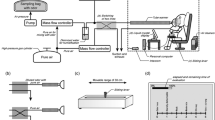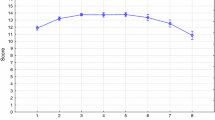Abstract
Weakened smelling is common in age. Two studies here show that this phenomenon frequently reveals itself in inability to detect ethyl mercaptan, the warning agent most commonly added to propane (LP-gas). The first study compared 21 young (18–25 years) with 21 old (70–85 years) persons for (a) detection threshold (average ten times higher in the elderly), (b) suprathreshold odor strength (weaker for the elderly at all levels), and (c) ability to identify common odors (the elderly did worse). Seven of the 21 elderly failed to detect ethyl mercaptan at or above a concentration associated with the boundary between acceptable and unacceptable levels of propane. Three of these failed to detect the odorant at a concentration where accompanying propane could explode. In the second study 50 of 110 persons over 60 years failed to detect odor reliably in commercial odorized propane diluted to the Department of Transportation's safety standard (one–fifth the lower explosive limit). Six of 52 persons under 40 also failed. The elderly person would seem at high risk of LP-gas fire.
Similar content being viewed by others
References
Chalke, H.D. and Dewhurst, J.R., “Accidental Coal-Gas Poisoning: Loss of Sense of Smell as a Possible Contributory Factor with Old People,”British Medical Journal, Vol. 2, 1957, pp. 915–917.
Cain, W.S. and Turk, A., “Smell of Danger: An Analysis of LP-Gas Odorization,”American Industrial Hygiene Association Journal, Vol. 46,1985, pp. 115–126.
Murphy, C., “Taste and Smell in the Elderly,”Clinical Measurement of Taste and Smell, edited by H.L. Meiselman and R.S. Rivlin, Macmillan, New York, 1986, pp. 343–375.
Goetzinger, J. W., Brinkman, D. W., Poling, B. E., and Whisman, M. C., “Vapor-Liquid Equilibrium Data of Ethanethiol and Tetrahydrothiophene in Propane,”Journal of Chemical and Engineering Data, Vol. 22, 1977, pp. 396–399.
Dravnieks, A. and Prokop, W.K., “Source Emission Odor Measurement by a Dynamic Force-Choice Triangle Olfactometer,”Journal of the Air Pollution Control Association, Vol. 25, 1975, pp. 28–35.
Cain, W.S., Gent, J.G., Catalanotto, F.A., and Goodspeed, R.B., “Clinical Evaluation of Olfaction,”American Journal of Otolaryngology, Vol. 4, 1983, pp. 252–256.
Whisman, M.L., Goetzinger, J.W., Cotton, F.O., and Brinkman, D.W., “Odorant Evaluation: A Study of Ethanethiol and Tetrahydrothiophene as Warning Agents in Propane,”Environmental Science and Technology, Vol. 12, 1978, pp. 1285–1288.
Stevens, S.S.,Psychophysics: Introduction to its Perceptual, Neural, and Social Aspects, Wiley, New York, 1975.
Stevens, J.C. and Marks, L.E., “Cross-Modality Matching Functions Generated by Magnitude Estimation,”Perception and Psychophysics, Vol. 27, 1980, pp. 379–389.
Bartoshuk, L.M., Rifkin, B., Marks, L.E., and Bars, P., “Taste and Aging,”Journal of Gerontology, Vol. 41, 1986, pp. 51–57.
Murphy, C. and Withee, J., “Age and Biochemical Status Predict Preference for Casein Hydrolysate,”Journal of Gerontology, Vol. 42, 1987, pp. 73–77.
Stevens. J.C., Plantinga, A., and Cain, W.S., “Reduction of Odor and Nasal Pungency Associated with Aging,”Neurobiology of Aging, Vol. 3, 1982, pp. 125–132.
Stevens, J.C., Bartoshuk, L.M., and Cain, W.S., “Chemical Senses and Aging: Taste versus Smell,”Chemical Senses, Vol. 9, 1984, pp. 167–179.
Stevens, J.C. and Cain, W.S., “Age-related Deficiency in the Perceived Strength of Six Odorants,”Chemical Senses, Vol. 10, 1985, pp. 517–529.
Schemper, T., Voss, S., and Cain, W.S., “Odor Identification in Young and Elderly Persons: Sensory and Cognitive Limitations,”Journal of Gerontology, Vol. 36, 1981, pp. 446–452.
Dotv, R.L., Shaman, P., Applebaum, S.L., Giberson, R., Siksorski, L., and Rosenberg, L., “Smell Identification Ability: Changes with Age,”Science, Vol. 226, 1984, pp. 1441–1443.
Cain, W.S., “Odor Identification by Males and Females: Predictions vs. Performance,”Chemical Senses, Vol. 7, 1982, pp. 129–142.
Data Furnished by the United States Fire Administration, Emmitsburg, MD 21727.
Moschandreas, D.J., Jones, D.R., Alpeter, L.L., “Factors which can Reduce the Olfactory Response to Natural Gas Odorants,” Presented at the 1983 International Gas Research Conference, London, June, 1983.
Author information
Authors and Affiliations
Additional information
Reference: Joseph C. Stevens, William C. Cain,and David E. Weinstein, “Aging Impairs the Ability to Detect Gas Odor,” Fire Technology, Vol. 23, No. 3, August 1987, pp. 198–204.
Note: The research was supported by NIH Grant AG-04287.
Rights and permissions
About this article
Cite this article
Stevens, J.C., Cain, W.S., Weinstein, D.E. et al. Aging impairs the ability to detect gas odor. Fire Technol 23, 198–204 (1987). https://doi.org/10.1007/BF01036936
Received:
Accepted:
Issue Date:
DOI: https://doi.org/10.1007/BF01036936




